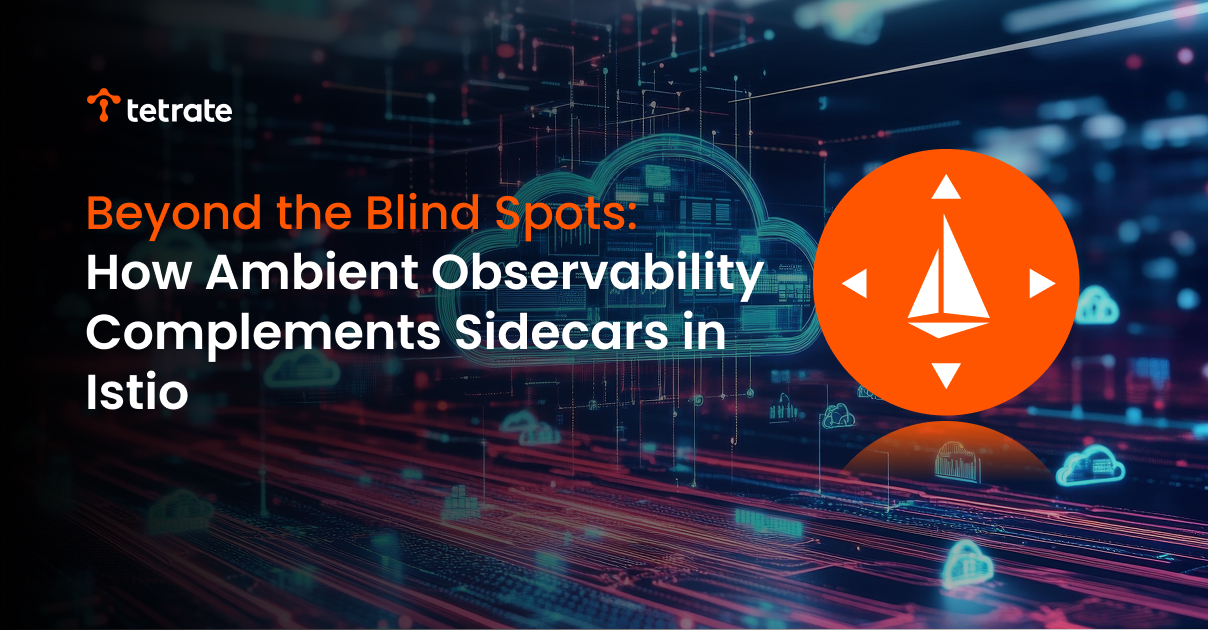Beyond the Blind Spots: How Ambient Observability Complements Sidecars in Istio
Ambient mode in Istio shifts observability from sidecars to shared infrastructure—delivering core telemetry with less overhead. This post explores how ambient offers scalable, consistent visibility across workloads, enabling a flexible, hybrid mesh strategy without the operational burden.

In our previous blog, we explored how Istio’s ambient mode offers a practical and incremental path to service mesh adoption—without the friction of sidecars. In this follow-up, we’re focusing on a key benefit of this new data plane architecture that often gets overlooked: ambient observability.
With ambient mode, observability shifts from a per-service implementation to a more scalable, infrastructure-level approach. Instead of capturing telemetry at the sidecar (service) level, ambient collects data at the node level—striking a balance between visibility and operational efficiency. You may trade some fine-grained detail for simplicity, but you gain broad, consistent insight across Kubernetes, VMs, clusters, and clouds—without the overhead of injecting and managing sidecars everywhere.
This blog explores where that tradeoff makes sense, and how to integrate ambient observability into a mesh strategy that gives you full coverage.
Ambient vs. Sidecars: A New Tradeoff in Observability
The sidecar architecture in Istio delivers deep observability: Layer 7 telemetry, fine-grained metrics, rich traces, and policy enforcement—all out of the box. But over time, some platform teams have hit limits with this model.
Managing thousands of sidecars can be operationally expensive. They add resource overhead, complicate upgrades, and introduce friction for onboarding workloads—especially in multi-cluster or VM-based environments. Observability itself isn’t difficult—but the way we implement it at scale can be.
That’s where ambient mode offers a compelling alternative.
What Ambient Mode Brings to the Table
It’s easy to assume that ambient mode sacrifices observability—but that’s not necessarily the case. Ambient still provides critical telemetry—it just does so differently than sidecars.
Rather than injecting a proxy into every pod, ambient mode uses a shared infrastructure model: Layer 4 zTunnels and optional Layer 7 waypoint proxies transparently collect metrics, handle encryption, and route traffic. This shift means you won’t get service-level granularity by default, but you do get the core metrics (latency, traffic, errors) that matter most—across environments, with less overhead.
Here’s how this benefits observability within the mesh:
Broad, Consistent Coverage
Ambient makes it easier to apply uniform observability across all workloads—Kubernetes, VMs, multi-cluster—without requiring per-service modifications or sidecar injection
Golden Signals with Less Overhead
You still get key metrics like latency, traffic, and error rates (Istio’s “golden signals”), but collected at the waypoint or zTunnel level. It’s not as granular as sidecars, but it’s lighter-weight and far easier to scale.
Fewer Gaps in Real-World Deployments
In complex environments, not every service ends up fully onboarded with sidecars. With ambient, platform teams can enforce observability policy more broadly, reaching workloads that would otherwise fall outside the mesh.
What You Trade Off—and Why That’s Okay
Ambient observability isn’t a drop-in replacement for sidecars. It doesn’t automatically provide full Layer 7 visibility or request-level telemetry for every call. And that’s by design.
For workloads where deep insights or custom policy enforcement are critical, sidecars still make sense. For everything else—especially when speed, scale, and simplicity matter—ambient gives you “good enough” observability with dramatically lower overhead.
Tetrate’s vision is about balance: use sidecars where needed, ambient where possible, and manage both from a single, unified control plane.
The Hybrid Model: Your Mesh, Your Way
Until now, the choice was binary: adopt sidecars and get Istio’s full feature set—with all the operational overhead—or skip the mesh entirely. Ambient mode introduces a new middle path. It offers a lighter-weight, infrastructure-level approach that delivers the most essential features—like mTLS and telemetry—without the overhead of sidecars. It’s not a full replacement, but for many workloads, it’s exactly the right balance of capability and simplicity.
In that sense, ambient observability isn’t about replacing sidecars—it’s about enabling a hybrid model. By combining ambient’s lightweight, scalable telemetry with the deep visibility of sidecars where needed, you can tailor observability to each workload. That flexibility is what makes ambient so powerful—it fills the gap between all-or-nothing mesh adoption and gives teams a practical, operationally sustainable path forward.
What’s Next
Ambient mode is not just a new data plane—it’s a new operational model. Observability is a perfect example of where this shows up in a big way: less friction, broader coverage, and better outcomes.
In our next post, we’ll dive into how ambient works with multi-clusters.
Until then, if you’re ready to remove blind spots from your service network, reach out to us to hear what ambient observability can do for your team.
Ready to Assess Your Istio Strategy?
Try the advisor now! Get personalized recommendations for your environment:










